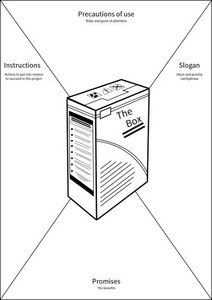The Product Box

The Product box is a classic from the Agile games line. The kind of typical workshop that turns an austere meeting room into a middle school classroom. In the usual version, this game needs a few accessories: A4 cardboard boxes, scissors, glue, stickers, and the participant’s imagination... This workshop definitely requires some logistical support. It takes about 2 hours to complete and you need one facilitator to manage 6 to 12 participants max.
Teams are asked to imagine that this product will be sold in a department store, just like another everyday product. As they imagine the product, they make decisions about its name, a slogan, a logo and 3 or 4 key selling points on the front of the packaging. And on the back of the packaging: a detailed description, the prerequisites and the conditions of use.
Goal
Create a product identity
Materials
Instructions
The exercise moves through three phases that can be played in groups of 3 to 9 participants.
Stage 1: Fill the box
First, the facilitator explains the goals to the teams: ”Let’s imagine that you have to sell…” It’s up to you to make your metaphorical project/product explicit!
Provide a few indications about the content that will appear on the front and on the back of the box:
*On the front of the packaging: name of the product and a catchy slogan.
*On the facing as well: the arguments, the benefits of this “product” and its major advantages.
*On the side: the instructions, in other words, the actions to implement your project.
*Finally, on the top: the precautions of use, the risks and the focused points.
This first stage is dedicated to discussion and divergence. In groups of 3, the participants discuss together, write down every idea on Post-it and organize them on paperboard to share it with the others sitting around the table.
Stage 2: Make the box
After the first stage, teams will share their ideas with the whole table. They will express new ideas, discuss and understand the issues by working together.
The facilitator will ask then the participants to gather their ideas in 3 or 4 major ones that everyone agrees on or not. Post-it needs to be reformulated and repositioned. The box is now synthetic, ready to be sold!
Stage 3: Sell the box
To design an innovative product is not enough; marketing departments are aware of that! The next step is to sell it which is only possible with some communication and some advertising.
The teams will show their box off to the others. You can organize a vote (show of hands, clapometer, the “pros” on one side of the room and the “cons” on the other one…). It can help the motivation of the team to announce that a prize will be awarded for the best box seller!
At that point, give the teams a set amount of time to prepare a pitch (10 minutes), which will be limited as well (around 2 minutes). You can time it to increase the challenge.
Attachments
- productbox.jpg
- product-box_en_pdf.pdf
Background
source: https://stormz.me/en/blog/stormz-games-product-box1
Back to the roots: Design the box.
This game was developed by Bill Shakelford and popularized by Jim Highsmith, both “founding fathers” of the Agile method. It is usually used to launch new projects, to help facilitate any vision-oriented discussion and to determine a new product’s range.
Author
👋 Hi there! I’m Alex, a facilitator and the founder of the AI Tinkerers’ Club. Back in 2012, I launched Stormz, a collaboration tool that facilitators love because it’s super easy to use. I didn’t stop there; I integrated AI features into Stormz and developed SparkitUp, introducing a novel way to brainstorm with AI. With my practical GenAI expertise, I train teams in AI fundamentals and lead workshops to pinpoint the most effective AI use cases.
More about author